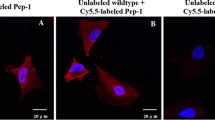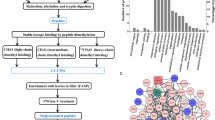Abstract
Objective
The aim of this study was to use lung cancer targeting binding polypeptide ZS-9 to screen cDNA library of human lung cancer and obtain ZS-9 specific ligand to confirm tumor marker of non small-cell lung cancer.
Methods
Artificially synthesize biotin labeled peptide ZS-9, anchored ZS-9 in the enzyme label plate coupled by avidin, used ZS-9 as probe to screen cDNA library of human lung cancer, after screening, obtained bacteriophage clone specifically binding with anchored polypeptide ZS-9. Extracted plasmid of bacteriophage and performed sequencing after amplified by PCR.
Results
It was demonstrated by bioinformatic analysis on the sequence of ligand binded by lung cancer specific peptide ZS-9 that the ligand was the cytoskeletal protein periplakin on the surface of lung cancer cells, suggesting that periplakin might be a new marker for non-small-cell lung cancer in lung cancer.
Conclusion
Use specific lung cancer binding peptide to screen new tumor marker periplakin in lung cancer and further studies on its biologic functions in genesis and development of lung cancer are still needed.
Similar content being viewed by others
References
Wang JY, Shi L, Dai SQ, et al. Screening of lung cancer specif ic peptide ZS-9 from a phage display peptide library and NCI-H1299 cells. Chin J Pathophysiol (Chinese), 2009, 25: 868–872.
Rougeon F, Mach, B. Stepwise biosynthesis in vitro of globingenes from globin m RN A by DN Apolymerase of avian myeloblastosis virus. Proc Natl Acad Sci USA, 1976, 73: 3418–3422.
Efstratiadis A, Kafatos FC, Maxam AM, et al. Enzymatic invitro synthesis of globin genes. Cell, 1976, 7: 279–288.
Tochitani S, Hayashizaki Y. Functional screening revisited in the postgenomic era. Mol Biosyst, 2007, 3: 195–207.
Jones JO, Diamond MI. Diamond, Design and implementation of cellbased assays to model human disease. ACS Chem Biol, 2007, 2: 718–724.
Yue WT, Wang ZT, Wang Y, et al. Construction and quality identification of T7 recombination expression cDNA library form human lung cancer. Chinese-German J Clin Oncol, 2009, 8: 195–198.
Song MH, Ha JC, Lee SM, et al. Identification of BCP-20 (FBXO39) as a cancer/testis antigen from colon cancer patients by SEREX. Biochem Biophys Res Commun, 2011, 408: 195–201.
Cooper CD, Lawrie CH, Liggins AP, et al. Identification and characterization of peripheral T-cell lymphoma-associated SEREX antigens. PLoS One, 2011, 6: 23916.
Jager D. Potential target antigens for immunotherapy identified by serological expression cloning (SEREX). Methods Mol Biol, 2007, 360: 319–326.
Nishimori T, Tomonaga T, Matsushita K, et al. Proteomic analysis of primary esophageal squamous cellcarcinoma reveals downregulation of a cell adhesion protein, periplakin. Proteomics, 2006, 6, 1011–1018.
Tonoike Y, Matsushita K, Tomonaga T, et al. Adhesion molecule periplakin is involved in cellular movement and attachment in pharyngeal squamous cancer cells. BMC Cell Biology 2011, 12: 41
Sun Q, Wang Y, Zhang Y, et al. Expression profiling reveals dysregulation of cellular cytoskeletal genes in HBx-induced hepatocarcinogenesis. Cancer Biol Ther, 2007. 6: 668–674.
Suzuki A, Horiuchi A, Ashida T, et al. Cyclin A2 confers cisplatin resistance to endometrial carcinoma cells via up-regulation of an Akt-binding protein, periplakin. J Cell Mol Med, 2010, 14: 2305–2317.
Mignogna MD, Fortuna G, Leuci S, et al. Metastatic prostate cancer presenting as paraneoplastic pemphigus: a favourable clinical response to combined androgen blockade and conventional immunosuppressive therapy. Br J Dermatol, 2009, 160: 468–470.
Yokokura H, Demitsu T, Kakurai M, et al. Paraneoplastic pemphigus mimicking erosive mucosal lichen planus associated with primary hepatocellular carcinoma. J Dermatol, 2006, 33: 842–845.
Zimmermann J, Bahmer F, Rose C, et al. Clinical and immunopathological spectrum of paraneoplastic pemphigus. J Dtsch Dermatol Ges, 2010, 8: 598–606.
Wang J, Zhu X, Li R, et al. Paraneoplastic pemphigus associated with Castleman tumor: a commonly reported subtype of paraneoplastic pemphigus in China. Arch Dermatol, 2005, 141: 1285–1293.
Li YM, Liu PH, Zhang YH, et al. Radiotherapy of unicentric mediastinal Castleman’s disease. Chin J Cancer, 2011, 30: 351–356.
Kennedy, NA, Dawe S. Atypical paraneoplastic pemphigus secondary to endometrial carcinoma with no mucosal involvement. Clin Exp Dermatol, 2009, 34: 130–133.
Taillé C, Grootenboer-Mignot S, Boursier C, et al. Identification of Periplakin as a New Target for Autoreactivity in Idiopathic Pulmonary Fibrosis. Am J Respir Crit Care Med, 2011, 183: 759–766.
Author information
Authors and Affiliations
Corresponding authors
Additional information
Supported by grants from the Science and Technology Planning Project of Guangdong Province (No. 2010B031600066; No. 2010B031500034; No. 2008B030303008); the Key Scientific Subject Foundation of Ministry of Education of China (No. 208105); and the National Science and Technology Major Projects for New Drugs (No. 2011zx09102-001-31).
Rights and permissions
About this article
Cite this article
Dai, S., Li, W., Kong, M. et al. Screening study on new tumor marker periplakin for lung cancer. Chin. -Ger. J. Clin. Oncol. 12, 305–309 (2013). https://doi.org/10.1007/s10330-013-1178-y
Received:
Revised:
Accepted:
Published:
Issue Date:
DOI: https://doi.org/10.1007/s10330-013-1178-y




